Yellow-headed birds often stand out amongst the foliage, catching our attention even when they are only there for a flash!
Despite birds coming in all sorts of colors, it’s the yellow birds (including those with yellow heads) that often catch our eye. That’s especially true if we live in an area with lots of sparrows and wrens, but not a lot of more colorful birds!
There are yellow and yellow-headed birds all over the world. In fact, in putting together this list, it was hard to limit the number to just 25! Still, any more than that, and the list was getting a little overwhelming! So here are 25 of the prettiest, most eye-catching, and most interesting birds with yellow heads from around the globe.
American Goldfinch

- Scientific Name: Spinus tristis
- Length: 4.3-5.1 in (11-13 cm)
- Weight: 0.4-0.7 oz (11-20 g)
- Wingspan: 7.5-8.7 in (19-22 cm)
What they look like: Males have a bright yellow body, black cap, and wings with white bars. Females are more muted in color, with a yellow wash on their heads instead of that signature bright yellow. Breeding-season males and females have a pinkish bill, whereas immature and non-breeding males have a blackish-gray bill.
Where they live: Found all over North America. They reed in Canada and the northern U.S., and they winter in the southern U.S. and Mexico. They are year-round residents of much of the area in between.
Interesting facts: The American Goldfinch is the state bird of Washington, Iowa, and New Jersey.
Blue-Winged Warbler

- Scientific Name: Vermivora cyanoptera
- Length: 4.3-4.7 in (11-12 cm)
- Weight: 0.3 oz (9 g)
- Wingspan: 5.9 in (15 cm)
What they look like: The Blue-winged Warbler has a yellow head and body, and blue-gray wings with white bars. The male’s eye line is black, whereas the female’s is slightly lighter gray. Although technically they are sexually dimorphic, males and females look very similar and are often difficult to distinguish in the field.
Where they live: They breed in eastern North America and winter in Central America. They migrate through the American Southeast but don’t stay there.
Interesting facts: They are usually found in abandoned fields and shrubby areas. They are also very loud singers in the spring when their breeding season begins.
Wilson’s Warbler

- Scientific Name: Cardellina pusilla
- Length: 3.9-4.7 in (10-12 cm)
- Weight: 0.2-0.3 oz (5-10 g)
- Wingspan: 5.5-6.7 in (14-17 cm)
What they look like: They have a yellow head and underparts, as well as olive green upperparts and wings. The male has a black cap on his head, whereas the female’s head is plain. They have tiny little bills.
Where they live: They breed in the western U.S. and Canada, then winter in Mexico and Central America. You can find them in most of the continental US during their migrations every spring and fall.
Interesting facts: They were named after Alexander Wilson, an American ornithologist and poet.
Yellow Warbler
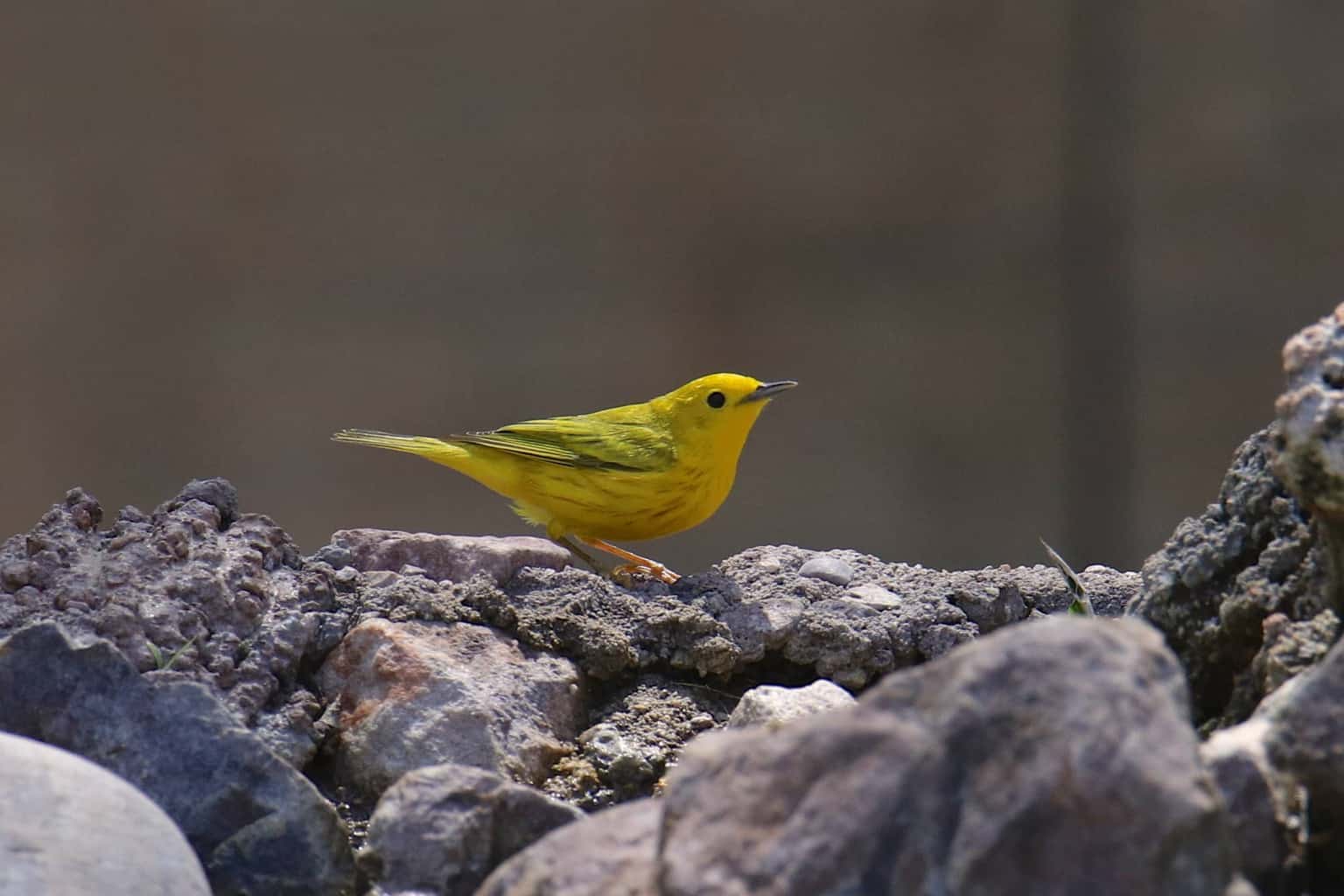
- Scientific Name: Setophaga petechia
- Length: 4.7-5.1 in (12-13 cm)
- Weight: 0.3-0.4 oz (9-11 g)
- Wingspan: 6.3-7.9 in (16-20 cm)
What they look like: The Yellow Warbler is very small and has a rounded body. It is entirely bright yellow, and the male has very light, reddish streaks on his chest. Their sharp, thick bill is excellent for eating large amounts of insects.
Where they live: They live throughout North and South America. They are known for migrating long distances.
Interesting facts: The Yellow Warbler is the most widespread and common warbler in North America.
Yellow-Headed Blackbird

- Scientific Name: Xanthocephalus xanthocephalus
- Length: 8.3-10.2 in (21-26 cm)
- Weight: 1.6-3.5 oz (44-100 g)
- Wingspan: 16.5-17.3 in (42-44 cm)
What they look like: The Yellow-headed Blackbird male is all black with a bright yellow head. The female has more patchy coloring, rather than such a dramatic contrast between the head and body. These birds are larger than one of the most common blackbirds in North America: the Red-Winged Blackbird. They have white wing patches which are visible when in flight.
Where they live: They live in the west and interior of the U.S. and Canada. They winter in the southwest U.S. and Mexico. They are not found in the eastern half of North America.
Interesting facts: Yellow-headed Blackbirds are found in marshes and wetlands. Their loud, squeaky call sounds like a rusty gate opening.
Prothonotary Warbler
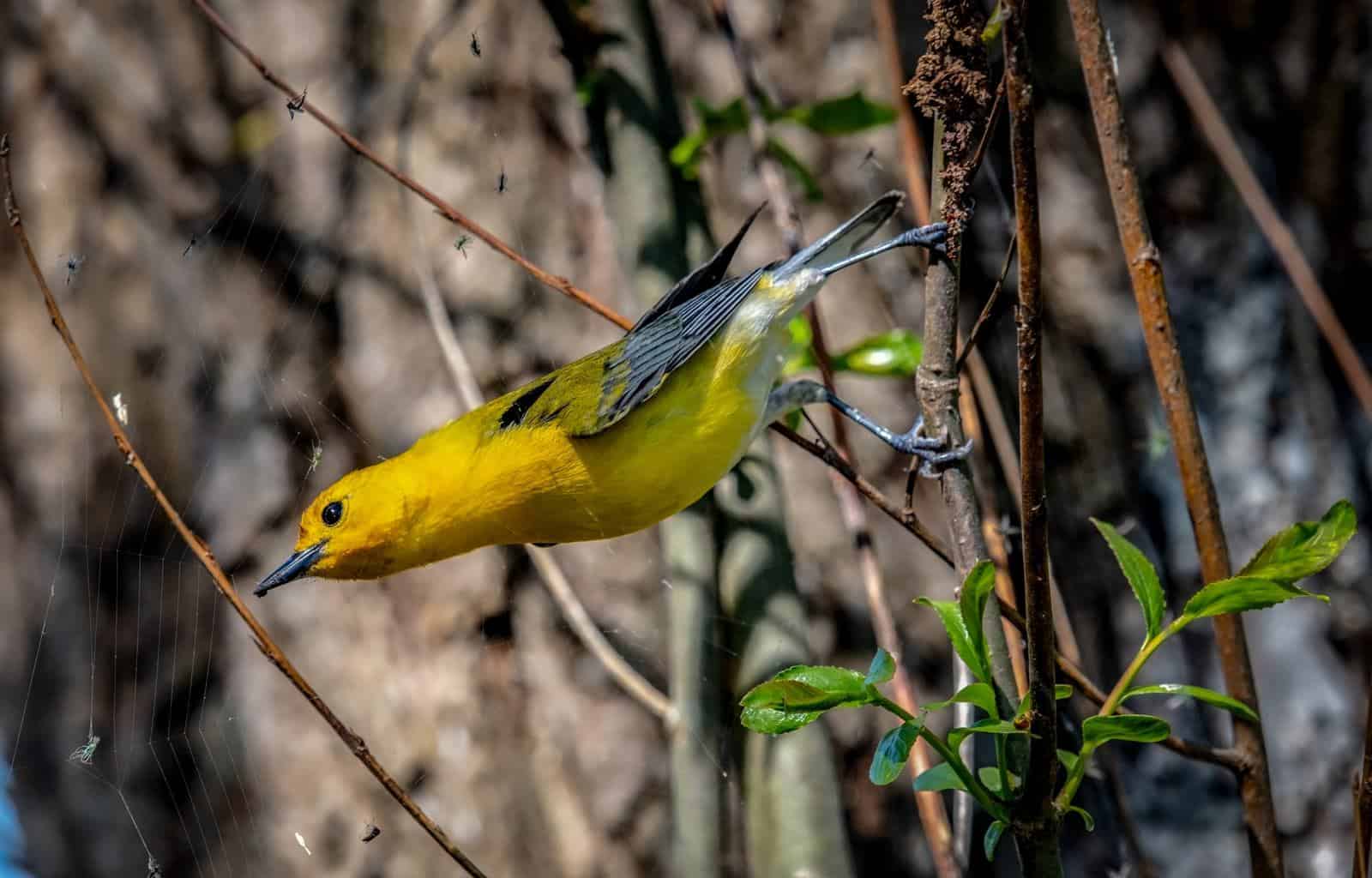
- Scientific Name: Protonotaria citrea
- Length: 5 in (13 cm)
- Weight: 0.4 oz (12.5 g)
- Wingspan: 8.75 in (22 cm)
What they look like: The Prothonotary Warbler has a bright yellow head and underparts, with blue-gray wings and tail. Females are longer, thinner, and lighter in their coloring.
Where they live: They breed in the eastern U.S. and winter in the West Indies and Central/South America. They are migratory visitors to the Caribbean Islands.
Interesting facts: Males build several incomplete nests to attract females. These are called “dummy nests.”
Yellow-Headed Brushfinch
- Scientific Name: Atlapetes flaviceps
- Length: Unknown
- Weight: Unknown
- Wingspan: Unknown
What they look like: The Yellow-headed Brushfinch has a yellow head, breast, and belly, with black wings and tail. When the first-ever photo of a Yellow-headed Brushfinch gave the impression that the bird’s head was green, it was temporarily called the Olive-headed Brushfinch.
Where they live: They are only found in interior Colombia.
Interesting facts: They are an endangered species with fewer than 1,000 left in the wild.
Saffron Finch

- Scientific Name: Sicalis flaveola
- Length: 5.5-6 in (15 cm)
- Weight: 0.7-0.8 oz (12-24 g)
- Wingspan: Unknown
What they look like: The Saffron Finch has a yellow head, breast, belly, and wings with brown streaks. Males and females are very similar in appearance, and they both have a short, brown bill.
Where they live: They live in South America, Hawaii, and coastal Mexico.
Interesting facts: They are found in open, grassy habitats. In many areas within their natural range, they are kept as caged pets.
Laysan Finch

- Scientific Name: Telespiza cantans
- Length: 7.5 in (19.05 cm)
- Weight: 1.2 oz (34 g)
- Wingspan: Unknown
What they look like: The Laysan Finch has a heavy yellow bill. Males have a yellow head and upperparts, a grey neck, and white underparts. Females are similar, with slightly less dramatic coloring.
Where they live: They are endemic to the Northwestern Hawaiian Islands — specifically, Laysan Island.
Interesting facts: They are closely related to the Nihoa Finch and named after Laysan Island where they were discovered.
Hawaii Amakihi
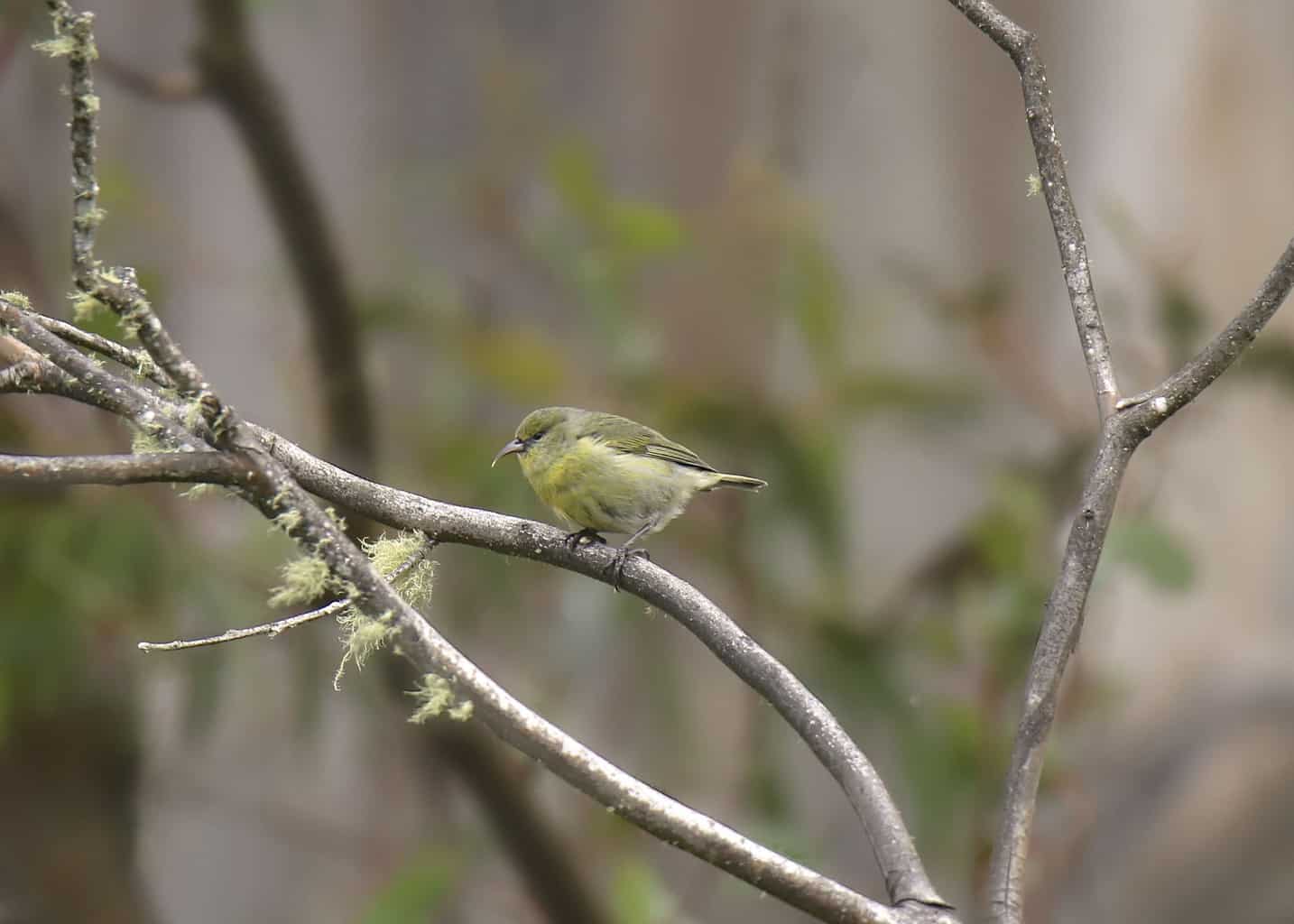
- Scientific Name: Chlorodrepanis virens
- Length: 4 in (10.16 cm)
- Weight: 0.4 oz (11.33 g)
- Wingspan: Unknown
What they look like: The Hawaii Amakihi has a pale yellow body with slightly darker wings and a slightly curved yellow beak. They have a signature dark gray eyestripe.
Where they live: They live on the Big Island, Maui, and Molokai in Hawaii.
Interesting facts: They have a flexible habitat, found in both dry and wet forests. Of all the Hawaiin honeycreepers, they are the least affected by climate change.
Kauai Amakihi
- Scientific Name: Chlorodrepanis stejnegeri
- Length: 5 in (12.7 cm)
- Weight: 0.7 oz (19.845 g)
- Wingspan: Unknown
What they look like: The Kauai Amakihi has a yellowish-green head and body with black and white striped wings. Males and females look similar to one another, with the males having slightly flashier coloring. They all have a short, sharp bill that curves downward.
Where they live: They are endemic to Kauai island in Hawaii.
Interesting facts: They have a curved bill adapted for drinking nectar. They also eat insects and fruit.
Anianiau

- Scientific Name: Magumma parva
- Length: 3.9 in (9.906 cm)
- Weight: 0.35 oz (9-10 g)
- Wingspan: 4.7-6.3 in (11.94-16 cm)
What they look like: The Anianiau is small with a yellow body. The male is somewhat uniform in its coloring; it has slightly darker yellow wings and tail along with a curved golden beak.
Where they live: They live in the upper forests of Kauai Island, Hawaii.
Interesting facts: They are the smallest Hawaiian honeycreeper. Nectar is their staple food but they will eat insects.
Akiapolaau
- Scientific Name: Hemignathus wilsoni
- Length: 5.5 in (13.97 cm)
- Weight: .99 oz (28.066 g)
- Wingspan: 7.5-8.7 in (19.05-22.09 cm)
What they look like: The Akiapolaau has a yellow head and chest with black wings. It has an unusually curved bill that makes it stand out from all other birds in its region.
Where they live: They live in both the dry and moist forests of Hawaii.
Interesting facts: They forage like woodpeckers, making them the only bird in Hawaii to do so. They are also an endangered species.
Palila
- Scientific Name: Loxioides bailleui
- Length: 6-6.5 in (15-16.5 cm)
- Weight: 1.3-1.8 oz (38-4 g)
- Wingspan: Unknown
What they look like: The Palila is a honeycreeper that has a yellow head and breast, white belly, and gray upper parts. It has a finch-like bill that is thick and strong, perfect for cracking into the seeds that make up its diet.
Where they live: They live in the dry forests on Hawaii’s Big Island.
Interesting facts: They are critically endangered and reliant on mamane trees for food and shelter.
Yellow-Headed Amazon

- Scientific Name: Amazona oratrix
- Length: 15-17 in (38-43 cm)
- Weight: 13 oz (368.544 g)
- Wingspan: 15 in (38 cm)
What they look like: The Yellow-headed Amazon, also known as the Yellow-headed Parrot or the Double Yellow-headed Amazon, has a green body with a bright yellow head and neck. It has red streaks on its wings.
Where they live: They live in Mexico and northern Central America. They are also popular pets but note that you can only purchase captive-bred Yellow-headed Amazons. They cannot be taken from the wild.
Interesting facts: They are highly intelligent and have speech abilities.
Yellow-Headed Warbler

- Scientific Name: Teretistris fernandinae
- Length: 5 in (12.7 cm)
- Weight: 0.2-0.6 oz (9-11 g)
- Wingspan: 6.5 – 8 in (16-20 cm)
What they look like: The Yellow-headed Warbler has a yellow head and light gray body with black wings and a thin, slightly curved beak.
Where they live: They live in Cuba, mostly on the western third of the island.
Interesting facts: They are a common and numerous species in Cuba, found in open habitats.
Maui Alauahio
- Scientific Name: Paroreomyza montana
- Length: Unknown
- Weight: 0.4 oz (11.34 g)
- Wingspan: Unknown
What they look like: The Maui Alauahio has a small yellow body with brownish wings. Both sexes are similar in appearance. It has a black eyestripe and a short, pointy black bill.
Where they live: They live on Maui Nui island in Hawaii but are also found on other Hawaiian islands.
Interesting facts: They forage on native plants but, unfortunately, they also face extinction due to habitat loss.
Altamira Oriole

- Scientific Name: Icterus gularis
- Length: 8.3-9.8 in (21-25 cm)
- Weight: 1.7-2.3 oz (47-64 g)
- Wingspan: 14.2 in (36 cm)
What they look like: The Altamira Oriole has a bright orange head, neck, and underparts with black wings that have white bars. It belongs on this list because the juvenile Altamira Oriole is yellowish-orange before aging into a full orange.
Where they live: They live in Mexico, Central America, and Texas.
Interesting facts: They are the largest New World oriole and eat fruit and insects.
Yellow Grosbeak

- Scientific Name: Pheucticus chrysopeplus
- Length: 8.5-9.4 in (21.5 – 24 cm)
- Weight: 2.2 oz (62 g)
- Wingspan: Unknown
What they look like: The Yellow Grosbeak has an entirely yellow body with black wings that have white spots and a large black beak. Grosbeak bills are especially large when compared to their small faces.
Where they live: They are endemic to western Mexico.
Interesting facts: They are also known as the “Mexican Yellow Grosbeak.”
Hooded Oriole
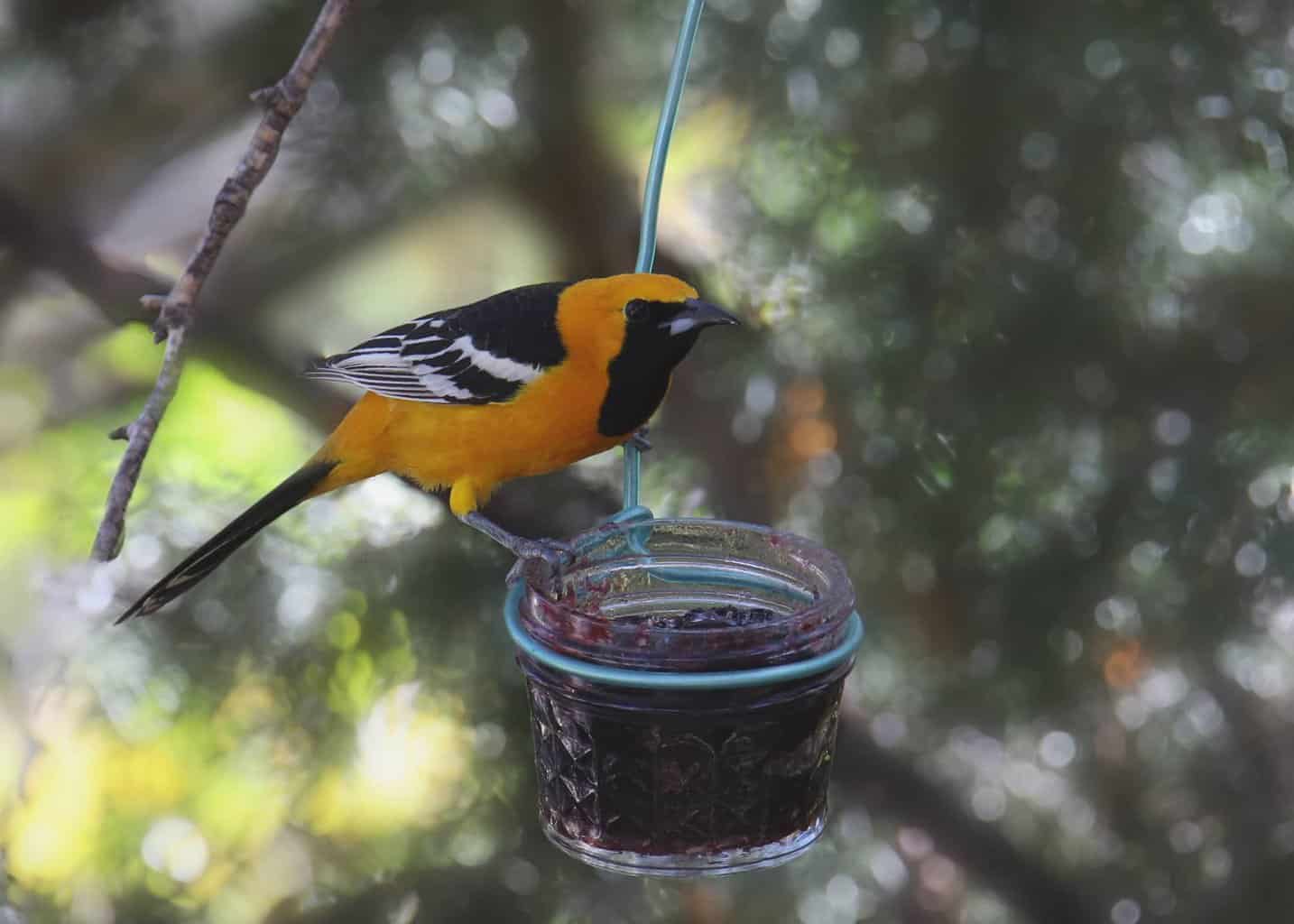
- Scientific Name: Icterus cucullatus
- Length: 7.1-7.9 in (18-20 cm)
- Weight: 0.8 oz (24 g)
- Wingspan: 9.1-11.0 in (23-28 cm)
What they look like: The Hooded Oriole has a yellow underside with a black face, neck, back, wings, and tail. It has a pointed bill and a bright yellowish-orange head. The female is lighter yellow without the black facial markings.
Where they live: They are short-distance migrants who live in the southwestern U.S., Mexico, and Central America.
Interesting facts: Their nests hang down from trees. Their diet consists mainly of insects and nectar.
Yellow-Throated Vireo

- Scientific Name: Vireo flavifrons
- Length: 5.1-5.9 in (13-15 cm)
- Weight: 0.5-0.7 oz (15-21 g)
- Wingspan: 9.1 in (23 cm)
What they look like: The small but chunky Yellow-throated Vireo has yellow spectacle markings around its eyes with a yellow throat and upper breast. Its back is gray and its wings are black with white bars. These birds are sexually monomorphic, so males and females look just alike.
Where they live: They are long-distance migrants who breed in eastern North America and winter in the tropics.
Interesting facts: They move methodically through branches while foraging. Their song is burry and meandering.
Eurasian Golden Oriole

- Scientific Name: Oriolus oriolus
- Length: 7.9-9.8 in (20-24 cm)
- Weight: 2.8 oz (79.37 g)
- Wingspan: 17.32-18.5 in (44-47 cm)
What they look like: The male Eurasian Golden Oriole has a yellow head, throat, and underparts, with black wings, tail, and eyes. The female is greenish and gray.
Where they live: They live in Europe, Asia, and Africa. They are found as far north as Scandinavia and as far south as South Africa.
Interesting facts: Males weave intricate hanging nests. These birds are omnivorous, eating insects, fruit, and nectar.
Eurasian Siskin

- Scientific Name: Spinus spinus
- Length: 4.3-5.1 in (11-12.5 cm)
- Weight: 0.4-0.7 oz (12-18 g)
- Wingspan: 7.9-8.7 in (20-23 cm)
What they look like: The Eurasian Siskin is a small finch with a yellow body, black cap, and wings, as well as broad yellow stripes and a forked tail.
Where they live: They are widespread across Europe and are also found in Asia and parts of North Africa.
Interesting facts: They are gregarious and often found in large flocks. They feed on seeds and insects.
Yellow Cardinal

- Scientific Name: Gubernatrix cristata
- Length: 7.87 in (20 cm)
- Weight: 1.62-1.79 oz (46–50.8 g.)
- Wingspan: Unknown
What they look like: The male Yellow Cardinal has an entirely yellow body with a black face mask and a very tall black crest at the front of his head. Females have grayer plumage but are still quite yellow.
Where they live: They live exclusively in south-central South America.
Interesting facts: It is the only member of its genus, and it is classified as endangered.
Golden Pheasant
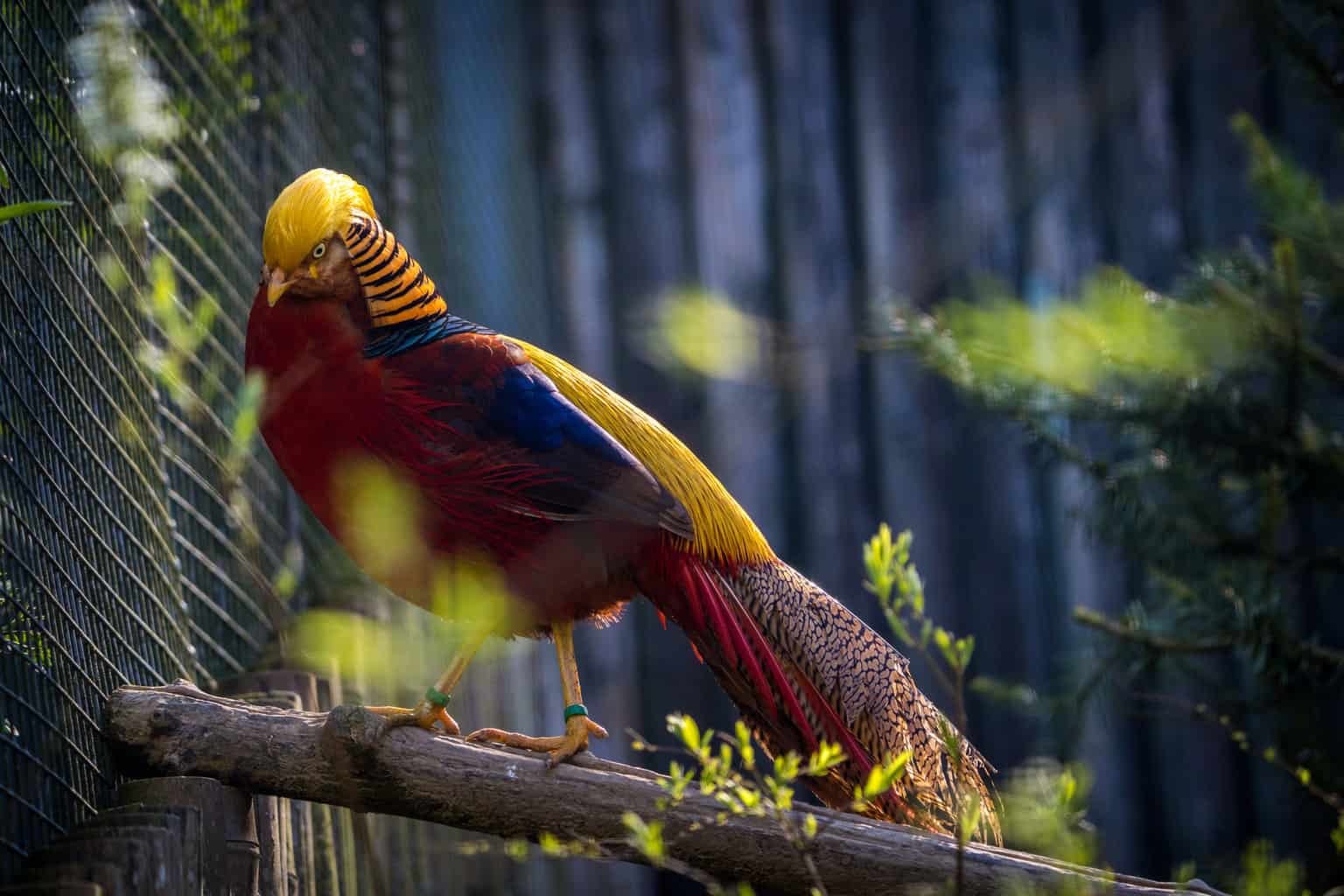
- Scientific Name: Chrysolophus pictus
- Female Length: 24-28 in (including tail) (60-70 cm)
- Male Length: 35-41 in (90-105 cm)
- Female Weight: 77 lb (350 g)
- Male Weight: 1.1-1.54 lb (500-700 g)
- Wingspan: 27 in (70 cm)
What they look like: Also known as the Chinese Pheasant, the stunning Golden Pheasant has a long yellow and red crest on its head, a yellow neck, and a red body. Its red wings are striped in black.
Where they live: They live in forested areas of western China. They are one of the most popular pheasants to be kept in captivity.
Interesting facts: Males are brightly colored while females have more subdued brown and black plumage.
Next Time You Spot a Yellow-Headed Bird…
This list covers only 25 different species of birds that have yellow heads, providing their scientific name, size measurements, appearance, habitat, and interesting facts for each one.
As you can see, there are warblers, finches, blackbirds, honeycreepers, pheasants, and more on our list! You may have noticed that many of these yellow-headed birds are found exclusively in Hawaii, but many yellow-headed migratory species can be found around the world.
Enjoy your birdwatching!

